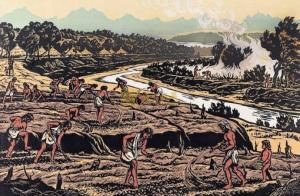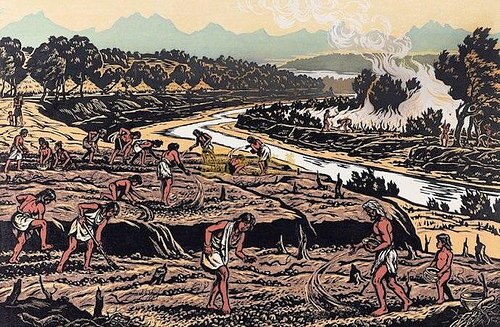
SCIENCE CHINA PRESS—China has a long tradition of agriculture production. Millet crops including foxtail millet and broomcorn millet were firstly domesticated in north China, and thereafter the development of millet-based agriculture (also called “rain-fed” agriculture) provided an important foundation for the emergence of ancient Chinese civilization, which might have also exerted an unprecedented impact on natural environments.
Previous studies revealed that the Yangtse River valley of south China and the Yellow River valley of north China were the original center of rice agriculture and rain-fed agriculture respectively. The history for the development of rain-fed agriculture during the Neolithic period has been intensively concerned, for central north China was the cradle for the origin of ancient Chinese civilization in the early 4th Millennium BP (Before present). Archaeologists have summarized the timeline for the development of rain-fed agriculture in Neolithic China, based on archaeobotanical evidences, while the space variation in this process has not been adequately studied and the spatial-temporal intensification and expansion of rain-fed agriculture in the Neolithic Age remains unclear.
The impact of slash-and-burn cultivation on the surrounding environments after the emergence of intensive rain-fed agriculture in China has also not been well understood due to the lack of interdisciplinary studies, for example, the cross-over studies between archaeology and earth sciences. The issue is valuable for the discussion of the hot-topic argument for the “Anthropocene”, which is nominated as a new geological epoch. Some scholars argue for the onset of the Anthropocene between 1945-1964 AD, when intensive atmospheric nuclear testing resulted in peak values of Carbon14, widely recorded in tree rings and sediments, while other scholars have argued its beginning may be traced back to the early Holocene. This latter argument is related to the beginnings of significant landscape modification through the development and spread of agricultural practices in the Old World since 10,000 BP.
In an article* coauthored by Guanghui Dong, Shanjia Zhang, Yishi Yang, Jianhui Chen and Fahu Chen, scholars at the MOE Key Laboratory of Western China’s Environmental System, Lanzhou University, suggest the intensification and expansion of agriculture during the Neolithic Age in northern China and its imprints in paleo-environmental records has been detected, based on the comparative analysis of multidisciplinary evidences.
These five scholars review the results of archaeobotanical and dating studies, and carbon isotope analysis of human bones from Neolithic sites, comparing them with black carbon content from palaeoenvironmental records in northern China. Based on this study, they conclude that millet cultivation was an auxiliary subsistence strategy in northern China from 10,000 to 7000 BP, with hunting-gathering the primary subsistence strategy, and that the earliest millet-cultivation might have emerged in eastern Inner Mongolia post 7700 BP. Millet cultivation transitioned from a secondary strategy to become dominant in the Guanzhong area of north-central China during 7000-6000 BP, and probably facilitated the development of early Yangshao culture in the middle reaches of the Yellow River valley. Intensive millet-based agriculture emerged and widely expanded across the Yellow River valley in northern China during 6000-4000 BP. This promoted rapid population growth and cultural evolution in the late Neolithic period, and was key to the subsequent emergence of the ancient Chinese civilization. The temporal-spatial variation of black carbon (EC-soot) corresponds well with the intensification and expansion of millet-based agriculture during Neolithic period, suggesting intensive millet agriculture production activities exerted evident impact on fire frequency in northern China.
______________________________
Artist illustration of slash-and-burn cultivation during the Neolithic Age. Courtesy Science China Press
______________________________
This work provides a valuable case study for understanding the temporal and spatial development of millet agriculture, and human-environment interactions in northern China during the Neolithic period from an Anthropocene perspective.
Source: Adapted and edited from the subject Science China Press news release
_________________________________________
*Dong G H, Zhang S J, Yang Y S, Chen J H, Chen F H. Agricultural intensification and its impact on environment during Neolithic Age in northern China (in Chinese). Chin. Sci. Bull., 2016, 61: 2913-2925, doi: 10.1360/N972016-00547.
_________________________________________

______________________________________________
Travel and learn with Far Horizons.
____________________________________________
This richly illustrated issue includes the following stories: Recent findings shedding new light on the whereabouts of the remains of Philip of Macedon, father of Alexander the Great; how an archaeologist-sculptor is bringing bones of the dead back to life; archaeologists uncovering town life at the dawn of civilization; an exclusive interview with internationally acclaimed archaeologist James M. Adovasio about what makes the Meadowcroft Rockshelter prominent in the ongoing search for the first Americans; what archaeologists are finding at the site of the ancient city of Gath, the home town of the biblical Philistine giant, Goliath; and how scientists are redrawing the picture of human evolution in Europe. Find it on Amazon.com.







